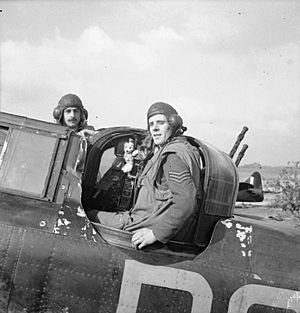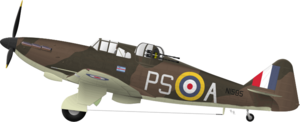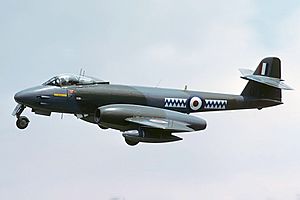Ted Thorn (RAF officer) facts for kids
Quick facts for kids
Edward Rowland Thorn
|
|
|---|---|

Flight Sergeants E R Thorn (left) and F J Barker (right) pose with their Defiant after destroying their 13th Axis aircraft; Thorn and Barker were the most successful Defiant crew of the war
|
|
| Born | 15 April 1913 North End, Hampshire |
| Died | 12 February 1946 (aged 32) Landbeach, Cambridgeshire |
| Buried |
Bishop’s Waltham (St. Peter) Churchyard. Hampshire
|
| Allegiance | United Kingdom |
| Service/ |
Royal Air Force |
| Years of service | 1928–1946 |
| Rank | Squadron Leader |
| Service number | 562610, later 46957 |
| Unit | No. 264 Squadron RAF No. 32 Squadron RAF No. 169 Squadron RAF |
| Battles/wars | Second World War |
| Awards | Distinguished Flying Cross & Bar Distinguished Flying Medal & Bar Mentioned in Despatches (2) |
| Relations | Marion Thorn (nee McAlpine) |
Edward Rowland Thorn (15 April 1913 – 12 February 1946) was a brave pilot in the Royal Air Force during the Second World War. He was also known as Roland Thorn. He became a famous "flying ace," which means he shot down many enemy planes.
Working with his gunner, Frederick Barker, Thorn shot down 12 enemy aircraft. This happened during the Dunkirk evacuation and the Battle of Britain. He survived the war, but sadly, he died in a jet fighter crash in 1946.
Contents
Early Life and Family
Edward Rowland Thorn was born in North End, Hampshire, England, on April 15, 1913. His father, Thomas Thorn, was a chef. When Rowland was three, his father died in the First World War.
He and his sister went to local schools in North End. At home, people called him Roland. Later, in the RAF, he was known as Ted. In 1939, he married Marion McAlpine. They lived in Bishop’s Waltham, Hampshire.
Joining the Royal Air Force
Thorn joined the Royal Air Force (RAF) in 1928 when he was 15. He trained to be an aircraft mechanic. Later, he became a pilot. By the early 1930s, he had earned his pilot's wings.
In October 1939, after the Second World War began, Thorn joined the new No. 264 Squadron RAF. This squadron flew the Boulton Paul Defiant fighter plane. The Defiant was unusual because its main weapons were four machine guns in a turret at the back. An air gunner operated these guns.
Thorn teamed up with leading aircraftman Frederick James Barker. They became a very successful team. Early on, German pilots often mistook the Defiant for the Hawker Hurricane. They would attack from behind, which was a blind spot for the Hurricane. But for the Defiant, this was exactly where the gunner's turret could fire!
Battles Over France and Dunkirk
Thorn and Barker saw a lot of action in May 1940. They fought over Dunkirk during the evacuation of Allied soldiers. On May 28, they shot down three Messerschmitt Bf 109 fighters.
The next day, May 29, they had even more success. They shot down a Junkers Ju 87 dive bomber and a Messerschmitt Bf 110 fighter. Later that day, they shot down another Ju 87 and Bf 110. They also helped destroy a Heinkel He 111 bomber.
On May 31, they shot down two more Heinkel He 111 bombers. They also damaged two others. The German air force, called the Luftwaffe, was trying to stop the evacuation. After Dunkirk, the Defiant became very vulnerable in daylight battles. The squadron had to rebuild.
On June 14, 1940, both Thorn and Barker received the Distinguished Flying Medal. This award was for their bravery and success as a fighter crew. Barker was also promoted to sergeant.
Fighting in the Battle of Britain
The Battle of Britain began, and 264 Squadron moved to RAF Hornchurch. From August 24 to August 28, 1940, the squadron suffered heavy losses.
On August 24, Thorn and Barker shot down a Junkers Ju 88 bomber. On August 26, they shot down two Dornier Do 17 bombers over Dover. As they attacked a third bomber, a Bf 109 attacked their Defiant. Their plane was badly damaged and caught fire.
Thorn quickly dived to try and crash-land the plane. The Bf 109 attacked again. Barker helped a Hurricane shoot down the enemy plane. Then, both Thorn and Barker bailed out of their burning Defiant. They were both slightly hurt.
Thorn and Barker became the most successful Boulton Paul Defiant crew of the entire war.
Later Career and Awards
The RAF realized the Defiant was not good for daylight missions anymore. So, its squadrons became night fighters. For their bravery in the Battle of Britain, Thorn and Barker received a Bar to their Distinguished Flying Medals on February 11, 1941. This meant they got a second medal.
As night fighters, Thorn and Barker destroyed a Heinkel He 111 bomber on April 9, 1941. This bomber was part of the "Blitz," which was when Germany bombed English cities.
Thorn continued to rise in the RAF. He became an officer in October 1941. He then joined No. 32 Squadron RAF to fly Hurricane fighters. This meant his successful partnership with Fred Barker ended.
Thorn was promoted several times. He became a squadron leader and commanded No. 32 Squadron RAF from April to September 1942. His squadron was very active during the Dieppe Raid on August 19, 1942. For his leadership and bravery, he received the Distinguished Flying Cross on September 22, 1942.
After this, he worked as an instructor, teaching young pilots. He was recognized again for his dedication in January 1944. He then joined No. 169 Squadron RAF as a flight commander. He led night missions against German night fighters over Europe. For these achievements, he received a Bar to his Distinguished Flying Cross in December 1944.
At the end of the war, he commanded a training unit. On January 1, 1946, he was recognized again for his skill as an instructor.
Tragic Death
On February 12, 1946, Squadron Leader Thorn was working at the Empire Central Flying School. This school flew early jet fighters. He was flying a Gloster Meteor F.3 jet when it crashed near Landbeach, Cambridgeshire. He died in the accident.
Honours and Awards
- 14 June 1940 – Distinguished Flying Medal (DFM) awarded to Sergeant Edward Rowland Thorn and Leading Aircraftman Frederick James Barker. They were recognized for their skill and determination in fighting the enemy. They had destroyed six enemy aircraft.
- 11 February 1941 – A Bar to the Distinguished Flying Medal awarded to Flight Sergeant Edward Rowland Thorn and Sergeant Frederick James Barker. This was for their continued bravery and success.
- 22 September 1942 – Distinguished Flying Cross (DFC) awarded to Acting Squadron Leader Edward Rowland Thorn. He was honored for his leadership and bravery, especially during the Dieppe Raid.
- 14 January 1944 – Mentioned in Despatches. This was for his dedication as an instructor.
- 8 December 1944 – A Bar to the Distinguished Flying Cross awarded to Acting Squadron Leader E. R. Thorn. This was for his achievements leading night missions.
- 1 January 1946 – Mentioned in Despatches. This was for his skill and dedication as a flying instructor and commander.
See also
- List of World War II flying aces



